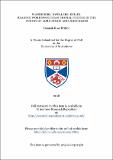Files in this item
Wanderers, dwellers, exiles : reading Wordsworthian spatial poetics in the poetry of Lord Byron and John Keats
Item metadata
| dc.contributor.advisor | Stabler, Jane | |
| dc.contributor.author | Britton, Hannah Rose | |
| dc.coverage.spatial | xvii, 255 p. | en_US |
| dc.date.accessioned | 2019-06-10T16:18:06Z | |
| dc.date.available | 2019-06-10T16:18:06Z | |
| dc.date.issued | 2018-12-07 | |
| dc.identifier.uri | https://hdl.handle.net/10023/17862 | |
| dc.description.abstract | This thesis is concerned with Wordsworth’s spatial poetics, with the formation and articulation of spatial identities and poetic geographies in his verse, and with the informing influence of those spatial poetics on the poetry of John Keats and Lord Byron. This thesis contends that Keats’s and Byron’s reception of Wordsworth’s poetry was intimately entwined with their understanding of the poet’s place: his geographical location in the Lake District and his place amongst the poets to whom they were heir. My research suggests that attending to the moments in Byron’s and Keats’s verse in which Wordsworthian spatial poetics emerge, are contested, and are reformed or absorbed, enables a deeper understanding of the poetic relationships between the poets and draws out strands of influence that have hitherto been overlooked. This thesis uncovers new areas of complex textual engagement between the Romantic poets by refocusing the discussion on the second-generation poets’ allusions to Wordsworth. Although Wordsworthian echoes and borrowings have been well traced in biographical and editorial work on Byron and Keats, there have been no extended critical studies. While building on the work of formal inheritance, this thesis also suggests a modification of the critical approach to the poetics of the nineteenth century that is implicitly, and often explicitly, framed as a question of Wordsworth or Byron. By uncovering complex intertextualities, this thesis suggests that there is more to be said on the moments in which the Romantic poets coalesce. The discussion is structured around an exploratory engagement with Wordsworth’s poetics in Lyrical Ballads (1800), which then informs readings of Byron and Keats. Through a selective engagement with their intertextual dialogue with Wordsworth, the thesis complicates previous studies of Romantic allusion by considering the experience of bodies in space and how those bodies are rendered textually. | en_US |
| dc.language.iso | en | en_US |
| dc.publisher | University of St Andrews | |
| dc.subject | William Wordsworth | en_US |
| dc.subject | Lord Byron | en_US |
| dc.subject | John Keats | en_US |
| dc.subject | Spatial poetics | en_US |
| dc.subject | Influence | en_US |
| dc.subject | Echo | en_US |
| dc.subject | Allusion | en_US |
| dc.subject | Spatial identity | en_US |
| dc.subject | Poetic geography | en_US |
| dc.subject.lcc | PR575.L3B8 | |
| dc.subject.lcsh | Wordsworth, William, 1770-1850--Criticism and interpretation | en |
| dc.subject.lcsh | Byron, George Gordon Byron, Baron, 1788-1824--Criticism and interpretation | en |
| dc.subject.lcsh | Keats, John, 1795-1821--Criticism and interpretation | en |
| dc.subject.lcsh | English poetry--19th century--History and criticism | en |
| dc.subject.lcsh | Romanticism--Great Britain | en |
| dc.subject.lcsh | Influence (Literary, artistic, etc.) | en |
| dc.title | Wanderers, dwellers, exiles : reading Wordsworthian spatial poetics in the poetry of Lord Byron and John Keats | en_US |
| dc.type | Thesis | en_US |
| dc.contributor.sponsor | Arts and Humanities Research Council (AHRC) | en_US |
| dc.type.qualificationlevel | Doctoral | en_US |
| dc.type.qualificationname | PhD Doctor of Philosophy | en_US |
| dc.publisher.institution | The University of St Andrews | en_US |
This item appears in the following Collection(s)
Items in the St Andrews Research Repository are protected by copyright, with all rights reserved, unless otherwise indicated.

